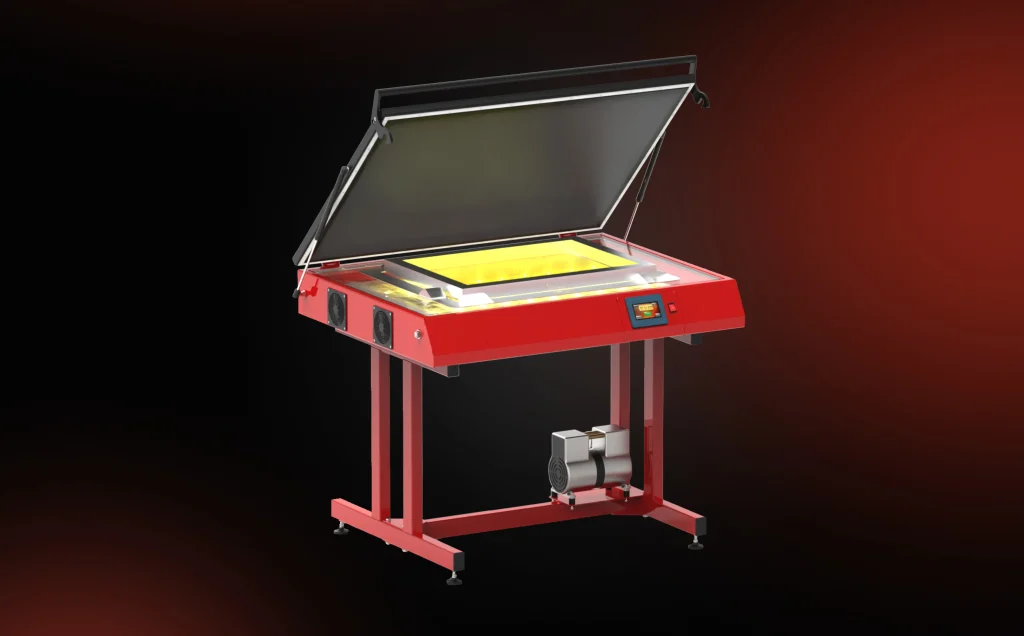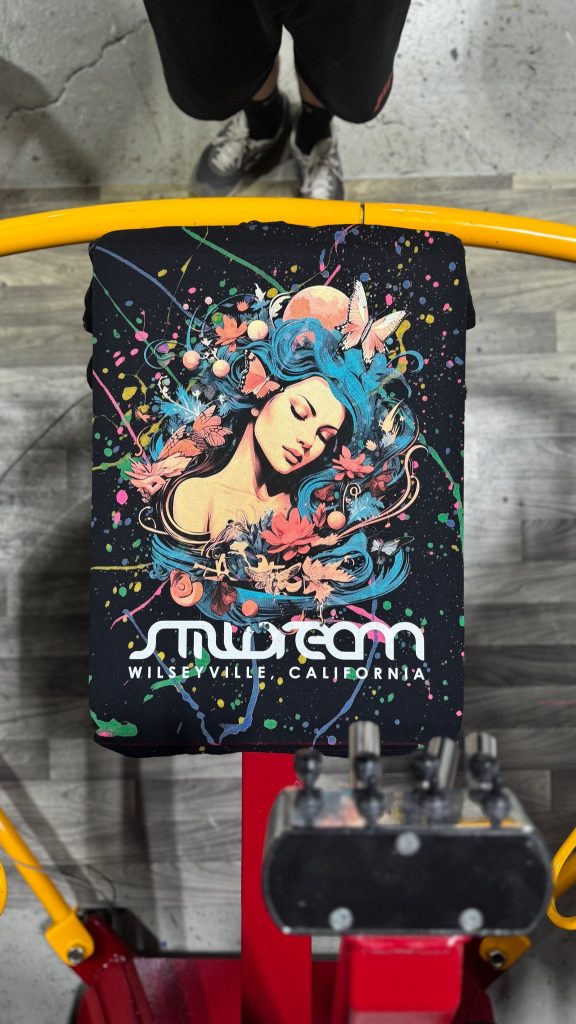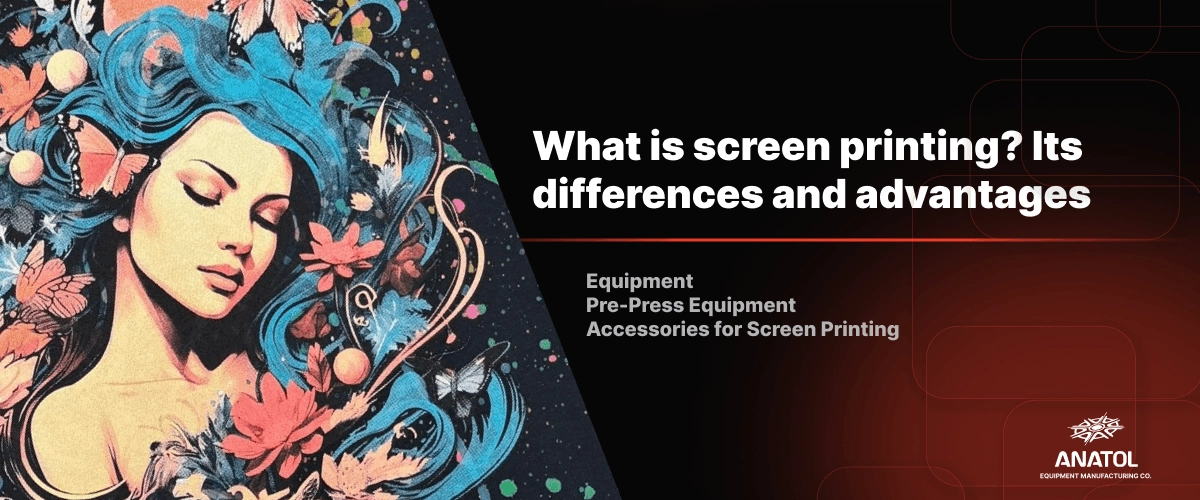History of Screen Printing
Screen printing, also known as silkscreen printing, has its roots in antiquity. This technique was first used in China around 960. Even then, silkscreen printing was used to apply patterns to fabric. Later, it spread throughout Asia. And in the 20th century, it became popular in Europe and the United States. A significant breakthrough came with the invention of the emulsion. It made the process more efficient and opened up new opportunities for mass production. You can learn more about the history of silk screen printing on Wikipedia
Overview of the Process
Screen printing is the process of transferring an image to a surface using a mesh grid and a stencil. First, a design is created and printed on a transparent film. Then it is transferred to the mesh, using UV exposure, covered with a photosensitive emulsion. Under the influence of light, the emulsion hardens, leaving the stencil in the form of open areas on the mesh. Through these openings, the ink is applied to the material, creating a print.
This process is used to print on fabrics, metal, glass, plastic, etc. Silkscreen printing is commonly used for T-shirts, posters, promotional products, and packaging. Its reliability and simplicity make it popular with both artists and large clothing manufacturers.

Advantages of Screen Printing Over Other Methods
One of the main advantages of screen printing is its durability. The inks penetrate deeply into the material, making the image resistant to wear and washing. This method is particularly effective for large production runs since the same stencil can be used to print thousands of items without significant additional costs.
Compared to digital printing, screen printing offers better color quality, especially for rich and vibrant hues. While digital printing is ideal for small runs and quick turnaround, screen printing remains more cost-effective for larger quantities. Heat transfer printing, on the other hand, is less suitable for long-lasting and complex images since its technology relies on temperature and is less resistant to washing and wear.
Screen printing remains one of the most reliable methods for creating high-quality, long-lasting prints that retain their vibrancy even after many cycles of use or washing, making it ideal for clothing and promotional products.
Benefits of Screen Printing for Businesses and Personal Use
Screen printing offers numerous advantages, making it popular for both large businesses and individual users. This method not only provides high print quality but also allows for scalable production with reduced costs. Let’s take a closer look at the key aspects that make screen printing such an effective solution for printing.
-
High Print Quality on Various Surfaces
One of the greatest benefits of screen printing is its ability to work with a variety of materials. Whether it’s fabric, glass, wood, plastic, or metal, this method delivers sharp and vibrant prints.
- Precision and clarity. Screen printing allows for highly detailed designs with great precision, which is especially important for logos, advertising images, or artwork.
- Color brightness. The inks used in screen printing have high color saturation, which makes the final products more expressive.
- No size limitations. You can print on large banners as well as small items.

Quote: “Screen printing ensures bright prints that don’t fade even after dozens of washing cycles.”
-
Mass Production at Low Cost
Screen printing is an ideal option for producing large quantities of products. Once the screens are prepared, each additional unit is significantly cheaper.
- Efficiency in large batches. After the screen preparation, printing thousands of units is fast and cost-effective.
- Lower costs with scaling. With each new unit produced, the cost per print decreases, making it economically viable for mass production.
For example, many companies use screen printing for promotional t-shirts or merchandise because it offers an excellent price-quality ratio for large orders.
-
Customization of Colors and Designs
Silkscreen printing provides extensive customization options. Customers can choose any colors, combine layers for multi-color designs, or use special effects such as metallic or fluorescent inks.
- Multilayer designs. Screen printing allows for the creation of complex, multi-color designs, as each color is applied in a separate layer. This is perfect for printing logos or branded products.
- Flexibility in ink choice. Various types of inks can be used: water-based, PVC, UV, or even glow-in-the-dark inks.
Quote: “Screen printing offers a rich array of possibilities for creating custom designs, making it perfect for branded products.”
-
Durability of Prints
One of the key factors that make silkscreen printing so popular is its durability. Screen-printed designs not only look bright but also last longer than those created with other methods.
- Resistance to wear. Screen-printed images are known for their durability in washing and friction. This is especially important for clothing that is frequently used, such as sportswear or workwear.
- Color retention. Even after repeated use and washing, the colors remain rich and vibrant.
This level of durability makes screen printing attractive for companies that want to produce high-quality products that last a long time, such as work uniforms or sports gear.
Differences Between Screen Printing, Digital Printing, and Heat Transfer Printing
-
Screen Printing: Mass Production and Durability
Screen printing is the classic choice for mass production, especially on clothing, plastic, glass, and other materials. Its main advantage is its efficiency in large runs — after the screen is prepared, each subsequent print costs significantly less.
- Durability: Screen-printed designs have a long lifespan thanks to the use of special inks that strongly adhere to the surface. They are resistant to mechanical damage, washing, and environmental influences, making this method ideal for textiles and workwear.
- Color brightness and saturation: Thanks to the thickness of the ink, screen printing ensures bright and saturated prints. Even after many wash cycles or wear, the colors remain clear and attractive.
-
Digital Printing: Speed and Cost-effectiveness for Small Runs
Digital printing is rapidly gaining popularity, especially for small runs and personalized products. It is based on direct printing from a computer onto the surface, without the need for physical stencils.
- Speed: Digital printing is ideal for small batches and urgent orders. Since there’s no need to create a screen, you can receive the finished product in a short time.
- Cost-effectiveness for small runs: For small production volumes, digital printing is more cost-effective because the preparation cost is minimal. This makes it a great choice for personalized orders like custom t-shirts or posters.
- Fewer color adjustments: Unlike silkscreen printing, digital printing offers limited options for vibrant colors. In addition, digital prints are often less resistant to wear and fading, especially on fabrics.
-
Heat Transfer Printing: Features and Applications for Special Materials
Heat transfer printing (or thermotransfer) is based on transferring an image from a thermal film onto a surface using high temperatures. This method is most often used for printing on specific materials such as polyester or nylon, where other methods don’t work as well.
- Application for special materials: Heat transfer printing is suitable for materials where other methods might be ineffective. For example, polyester or sports fabrics that require special handling for printing images.
- Flexibility in use: This method allows for printing small batches with different designs without the need to create separate stencils for each color or print.
- Limited durability: However, heat transfer printing is less durable than screen printing. After several washing cycles, the print may lose its brightness or even begin to peel off from the fabric.
Conclusion
Screen printing, digital printing and thermal transfer printing each have unique advantages and applications. Silkscreen printing provides durability and is cost-effective for mass production. Digital printing offers speed and flexibility for small runs. Thermal transfer printing is a great choice for specialized materials, although it lacks durability.

